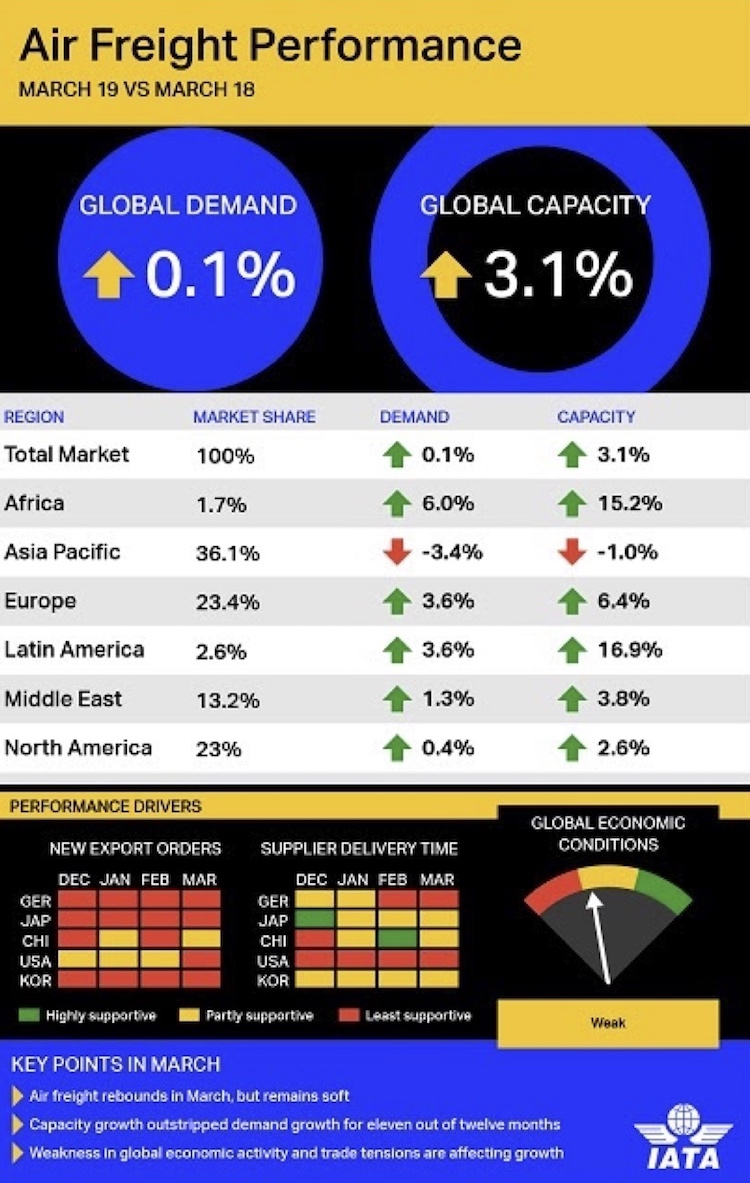
While global cargo volumes recovered slightly in March after four consecutive months of contraction, capacity has continued to grow, outstripping freight demand for 11 out of the past 12 months, new figures show.
The International Air Transport Association (IATA) monthly report on air freight markets showed demand, measured by freight tonne kilometres (FTKs), increased 0.1 per cent in March after a 4.9 per cent contraction in February.
Meanwhile, freight capacity, measured by available freight tonne kilometers (AFTKs), rose 3.1 per cent.
The Asia Pacific market was the only region to buck the positive March trend, with both demand for air freight and capacity shrinking on the back of weaker manufacturing conditions for exporters, trade tensions and a slowing Chinese economy.
However, IATA said Asia Pacific’s 3.4 per cent decrease in freight demand in March, compared with the prior corresponding month, was an improvement on the 12 per cent decline in February. Capacity in the region decreased by one per cent in the same timeframe.
While year-on-year demand for air freight had edged back into positive territory, trade tensions and shrinking order books had not gone away, IATA director general and chief executive Alexandre de Juniac said.
de Juniac said demand for air cargo continued to face significant headwinds as economic activity and consumer confidence weakened.
In spite of the flat market, IATA said industry confidence remained “relatively upbeat”, with only 13 per cent of respondents from its business confidence survey expecting lower freight volumes this year compared with calendar 2018, while 54 per cent expected increased volumes.
Global trade volumes had fallen by one per cent over the last year on the back of sliding manufacturers’ export orders that had started in September 2018, according to the Purchasing Managers Index.
Air freight volumes were down 1.5 per cent in the same period, leaving them around the mid-2017 level. Since their most recent peak FTKs were down four per cent from their most recent peak in August 2018.

African carriers posted the fastest growth of any region in March, with freight demand for the month up six per cent on March 2018.
Middle Eastern airlines’ freight volumes increased 1.3 per cent in March 2019 compared with March 2018, while capacity was up 3.8 per cent.
“A clear downward trend in seasonally-adjusted international air cargo demand is now evident with weakening air freight volumes to and from North America and to and from Asia Pacific [from the Middle East], contributing to the softer performance,” IATA said.
Latin American airlines experienced freight demand growth 3.6 per cent in March 2019, compared with the prior corresponding period, with capacity up 16.9 per cent.
Freight demand for North American airlines increased by 0.4 per cent in March 2019, compared to the same period a year earlier. New export orders were rising, supporting air cargo growth, IATA said. The region’s capacity increased by 2.6 per cent over the past year.
European airlines posted a 3.6 per cent increase in freight demand in March 2019 compared to the same period a year earlier. Capacity increased by 6.4 per cent year-on-year in the region.
“Given the weaker manufacturing conditions for exporters in Germany, and uncertainty over Brexit, March’s performance [for European airlines] represents a positive outcome,” IATA said.
IATA represents 290 airlines comprising 82 per cent of global air traffic.
















